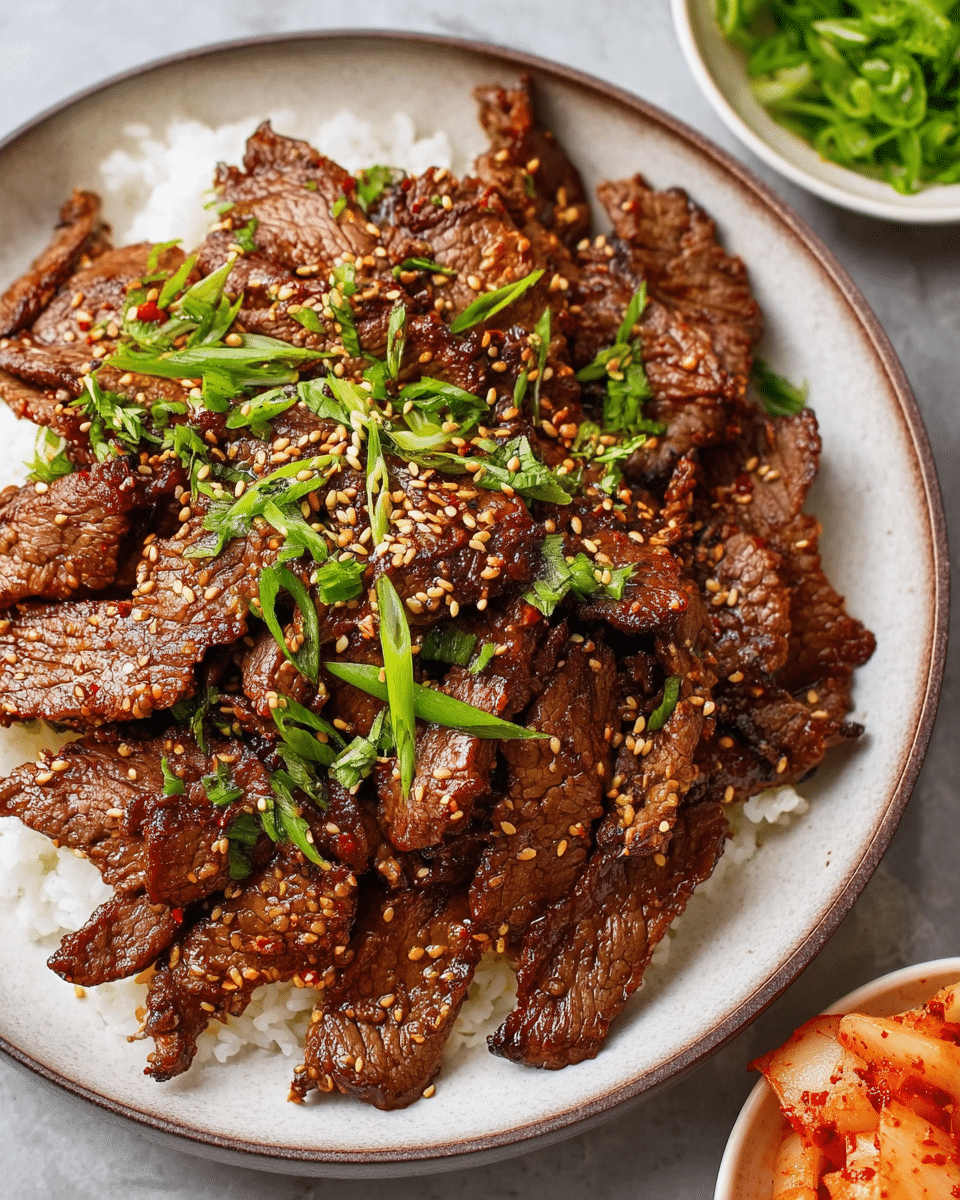Korean Beef Bulgogi is a popular dish made with thin slices of beef marinated in a flavorful mix of soy sauce, sugar, sesame oil, garlic, ginger, and pear. It’s quick to prepare, cooks in just a few minutes, and delivers that classic Korean BBQ flavor. This recipe is easy enough for busy weeknights and perfect for a flavorful dinner.
Full Recipe:
Ingredients
-
1 ½ pounds boneless ribeye steak
-
½ small pear, peeled and coarsely grated
-
¼ cup reduced-sodium soy sauce
-
2 tablespoons brown sugar
-
2 tablespoons toasted sesame oil
-
3 cloves garlic, minced
-
1 tablespoon freshly grated ginger
-
1 tablespoon gochujang (Korean red pepper paste)
-
2 tablespoons vegetable oil, divided
-
2 green onions, thinly sliced
-
1 teaspoon toasted sesame seeds
Directions
-
Wrap the steak in plastic wrap and freeze for 30 minutes. Then unwrap and slice it across the grain into ¼-inch thick slices.
-
In a medium bowl, mix together the grated pear, soy sauce, brown sugar, sesame oil, garlic, ginger, and gochujang.
-
Place the sliced steak in a large Ziploc bag, add the marinade, and marinate in the fridge for at least 2 hours or overnight, turning the bag occasionally.
-
Heat 1 tablespoon of vegetable oil in a cast-iron grill pan over medium-high heat.
-
Cook the steak in batches, adding it to the pan in a single layer. Cook each batch for 2-3 minutes per side, until charred and cooked through.
-
Repeat the process with the remaining vegetable oil and steak.
-
Serve immediately, garnished with sliced green onions and sesame seeds.
Nutritional Value (Per Serving – About 1/6 of the Recipe)
-
Calories: 350-400 kcal
-
Total Fat: 25-30g
-
Saturated Fat: 5-7g
-
-
Cholesterol: 60-80mg
-
Sodium: 700-800mg (due to soy sauce)
-
Total Carbohydrates: 8-10g
-
Dietary Fiber: 0-1g
-
Sugars: 7-9g
-
-
Protein: 25-30g
-
Vitamin A: 2-4% of the daily value
-
Vitamin C: 4-6% of the daily value
-
Calcium: 4-6% of the daily value
-
Iron: 10-15% of the daily value
These values are approximate and can vary depending on factors like the exact ingredients used, portion sizes, and marination time.
Why Korean Beef Bulgogi Stands Out
What sets Korean Beef Bulgogi apart from other beef dishes is its marinade, which is key to infusing the meat with bold flavors. The blend of soy sauce and brown sugar creates a sweet and salty base, while the sesame oil adds richness and depth. Fresh garlic and ginger lend their distinctive, aromatic qualities, and the grated pear adds natural sweetness and helps tenderize the meat. Finally, gochujang, the Korean red pepper paste, provides just the right amount of heat and complexity, bringing the dish to life with a gentle, lingering spice.
One of the best parts about this recipe is how versatile and adaptable it is. The marinade can be used for other proteins like chicken or pork, and it can also be adjusted to suit individual taste preferences. Whether you like it spicier or sweeter, the ingredients in this marinade allow for easy customization, making it a go-to recipe for anyone looking to explore Korean flavors in their kitchen.
The Magic of the Marinate and Freeze Method
One of the most effective ways to make Korean Beef Bulgogi is to marinate the beef for at least two hours or, ideally, overnight. The marinade allows the flavors to deeply penetrate the meat, creating a tender, flavorful bite with each slice. However, there’s an additional step in the preparation process that makes this recipe even better: freezing the beef before slicing it. Wrapping the boneless ribeye steak in plastic wrap and freezing it for about 30 minutes ensures that the beef firms up just enough to make slicing thinly across the grain much easier. Thin slices are essential for the texture of bulgogi, as they allow the marinade to coat the beef more effectively and cook quickly, resulting in a tender, flavorful dish.
Cooking Methods for Beef Bulgogi
While the traditional way to cook bulgogi is on a grill, using a cast-iron grill pan works wonderfully at home and allows you to achieve that signature charred, crispy texture. The key is to cook the beef in batches, ensuring that each slice is cooked evenly and has enough space to sear properly. The process only takes 2-3 minutes per side, so the beef cooks quickly, maintaining its juicy tenderness without drying out.
For those without a grill pan, a regular cast-iron or non-stick skillet will also work. The result may differ slightly in texture, but the rich, savory flavors will remain intact. The quick cooking time ensures that the beef doesn’t have the chance to overcook, and the caramelization from the sugar in the marinade adds a delightful crispy exterior that contrasts beautifully with the soft, juicy interior.
The Ideal Cut of Beef
Ribeye steak is often the cut of choice for Korean Beef Bulgogi because it strikes a perfect balance between tenderness and flavor. The marbling in ribeye provides a rich, juicy bite that enhances the overall dish. However, if ribeye is not available, flank steak or sirloin can be used as well, though they might not be as tender as ribeye. The thin slicing method, however, ensures that even leaner cuts can still result in a flavorful and tender dish.
Serving Korean Beef Bulgogi
Korean Beef Bulgogi is often served with steamed rice, which acts as a neutral base to balance out the strong flavors of the beef. The dish can also be accompanied by a variety of side dishes, known as banchan, such as kimchi, pickled vegetables, or sautéed spinach. These sides not only complement the flavors of the bulgogi but also provide a variety of textures that enhance the overall meal experience.
The dish is typically garnished with thinly sliced green onions and a sprinkling of toasted sesame seeds, adding a bit of crunch and a fresh, bright flavor that contrasts with the richness of the beef. For an extra layer of flavor, a drizzle of additional sesame oil or a side of gochujang sauce can be added to taste, elevating the spice level and complexity.
Why Korean Beef Bulgogi is Perfect for Weeknight Dinners
Korean Beef Bulgogi is an ideal weeknight meal for several reasons. First, the preparation time is minimal, especially if you’re able to marinate the beef ahead of time. Since the beef cooks so quickly, it’s easy to have a hot, flavorful meal ready in under 30 minutes. Second, the dish is customizable, so you can adjust the ingredients to suit your taste, or even make it milder for kids or those not accustomed to spice. Finally, bulgogi is a crowd-pleaser. Whether you’re cooking for family or friends, this dish is sure to impress with its bold, balanced flavors and quick cooking time.
The Nutritional Profile of Korean Beef Bulgogi
While Korean Beef Bulgogi is undoubtedly delicious, it also offers some nutritional benefits, particularly from the protein in the beef. A typical serving of this dish (about 1/6 of the recipe) contains around 25-30 grams of protein, which is essential for muscle growth and repair. The beef also provides iron, a critical mineral for blood health, as well as small amounts of vitamins and minerals like vitamin A, vitamin C, and calcium.
However, as with many flavorful dishes, it’s important to be mindful of the sodium content due to the soy sauce. The reduced-sodium soy sauce used in this recipe helps to keep the sodium levels in check, but if you’re watching your salt intake, it’s something to keep in mind. The dish is also rich in fat, particularly from the sesame oil and beef, but much of it comes from healthy fats that contribute to the flavor and texture of the dish.
Conclusion
Korean Beef Bulgogi is a vibrant, flavorful dish that brings the essence of Korean BBQ right into your kitchen. With its easy-to-make marinade, quick cooking time, and customizable flavors, it’s a perfect weeknight dinner that will leave everyone at the table satisfied. The rich, savory taste of the marinated beef, combined with its slight sweetness and spice, creates an unforgettable meal that will have you coming back for more. Whether served with a side of rice, vegetables, or simply on its own, Korean Beef Bulgogi is a delicious and convenient way to enjoy Korean cuisine at home. So, fire up your grill pan and try this recipe — your taste buds will thank you!






